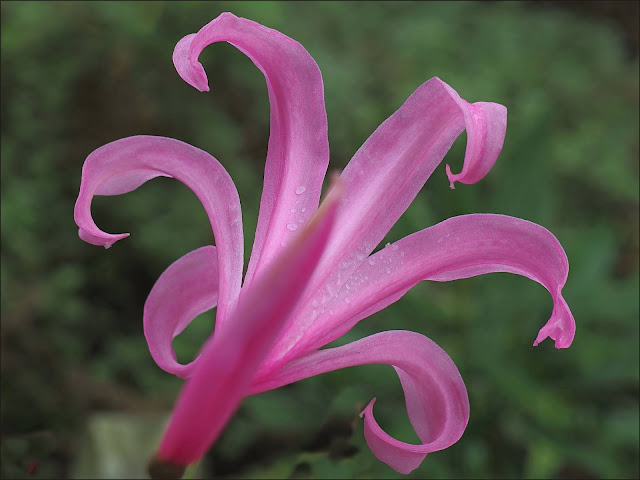A couple of difficult choices for me when I visited the Cambridge University's Botanic Garden this month. Flowers are not plentiful in October and some of those that are still blooming look a bit sad after all the rain we've been having in the last week or two. Trees, on the other hand, gave me the opposite problem: lots of them are now beginning to get autumn colour.
Cornish Lily, Guernsey Lily or Cape Flower - Nerine bowdenii
These lovely flowers brought a small explosion of colour at the entrance to the Glasshouse Range. The names are misleading; it doesn't come from Cornwall, or Guernsey, and it's not a lily. Cape flower is a better name as it is a native of southern Africa.
The bulbs were first sent back to the UK by Athelstan Cornish-Bowden, so that's where the Cornish bit comes from, though the scientific name comes from the other element of his double-barrelled name. Bowden Lily is also sometimes used.
It's actually a member of the Amaryllis family (Amaryllidaceae), which also includes, along with Amaryllis of course, daffodils, alliums, agapanthus and a whole host of what seem like very different plants.
Like the familiar Amaryllis it grows from a huge bulb, though it's much more reluctant to flower, needing ideally to be left undisturbed for a few years. I presume these are stored away somewhere in the Botanic Garden and just brought out when they are about to flower.
According to Wikipedia the bulbs contain chemicals which may prove useful in the treatment of Altzheimer's disease. Lets hope it does.
Transcaucasian Birch - Betula medwediewii
At first I thought I'd choose one of the spectacular autumn trees growing around the lake (we'll save them for another post). Then I remembered the birch grove which always has the look of a pointillist painting, dotted with golden leaves, at this season. But when I got there I saw the tree in the photo above, which piqued my curiosity.
"What the hell is that?" said my curiosity. Birch trees don't grow like that, do they? Well, most of the hundred-odd species of them don't. They grow like regular trees, like this....
The Transcaucasian Birch is a rare and endangered tree. There is a cultivar of it which is grown in gardens, but the original, sprawling growth-habit is rarely seen. It's an uncommon tree throughout its natural range in Georgia, Armenia and Iran. It's slow growing and of little economic value. It's not much grown in gardens, though apparently it can be trained to grow like a normal tree - but why not grow one of the other birches which do so naturally?
I rather like the way that it tries to go in several unexpected directions at once and almost ties itself in knots in doing so - but then, I've spent my life doing that!
Take care.











I have Nerine bowdenii that live in the garden all year round. This year they have sadly failed to flower so perhaps I should be doing as you suggest i.e storing them away and bringing them out just before they flower.
ReplyDeleteAccording to the RHS page on the flower:
Delete"Non-flowering: It is not unusual for newly planted bulbs to often take a year or two before flowering. Where clumps of bulbs become very congested the size and number of flowers will eventually decline if they are not divided".
Hope that helps.
Both featured plants are great. I especially like the birch.
ReplyDeleteMany of the reasons you continue to visit the gardens are embodied in this post. As for tying myself in knots, I am quite confident I could offer post graduate training to others!
ReplyDeletethe flower from South Africa is quite a beauty, no matter its name. Interesting about that birch having chemical properties that may help in Alzheimer's. Fingers crossed.
ReplyDeleteLovely plants, I do like the looks of that birch twisting itself up.
ReplyDeleteWhat an interesting flower, and I do enjoy my amaryllis in the winter time. I'm glad to know that its cousins' bulbs might help those with Alzheimers. I also enjoy that birch that has such interesting growth. Very elaborate!
ReplyDeleteLovely flowers!
ReplyDeleteThose pink lilies are gorgeous! Great photos!
ReplyDeleteI love how it sprawls out every which way. Sometimes straight up is over-rated.
ReplyDeleteI'm a bit of a Transcaucasian birch myself John, in the tying myself in knots sense 😉 Gorgeous pink lilies 🌸
ReplyDeleteWe planted pink nerines bulbs in a pot this year, we had lots of leaf but no flowers so it was lovely to see them in your photo. I love the twists and turns in the branches of the tree and your close up of its leaves:)
ReplyDeleteThe cape flower is elegant and looks gorgeous John.
ReplyDeleteI'm glad there is still colour around!
ReplyDeleteAwesome pretty color!
ReplyDeleteAlways love seeing your photos from Cambridge University's Botanic Garden. It such a beautiful place to walk and enjoy the beauty.
ReplyDeleteWow - how gorgeous!
ReplyDeleteI grow Nerines but red ones. I was interested in the comment on Alzheimer's.
ReplyDeleteThat's a great tree. I've never heard of it before so I enjoyed learning something new :)
ReplyDeleteHi John - love the Nerines ... while the Transcaucasian Birch is a delight ... I'd love to have one of those in a garden. Fascinating ... cheers Hilary
ReplyDelete